People
Anthony Haden-Guest’s Intrepid Lives of the Street Artists, Part II
Street artists speak on the perils of working in public spaces.
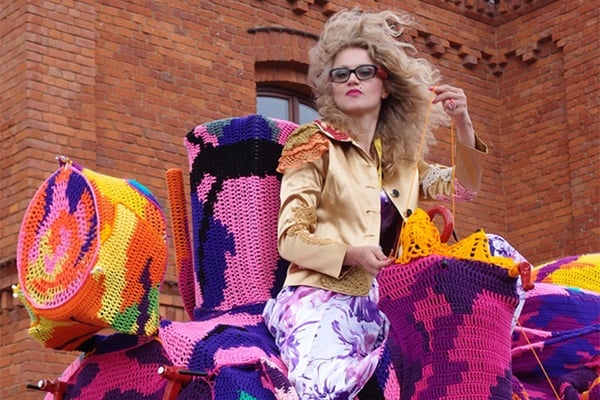
Image: via artist's website.
Street artists speak on the perils of working in public spaces.

Anthony Haden-Guest

This is the second in a four-part series in which Anthony Haden-Guest engages Street artists in dialogue about their practice from the 1960s to today. (See the first part here).
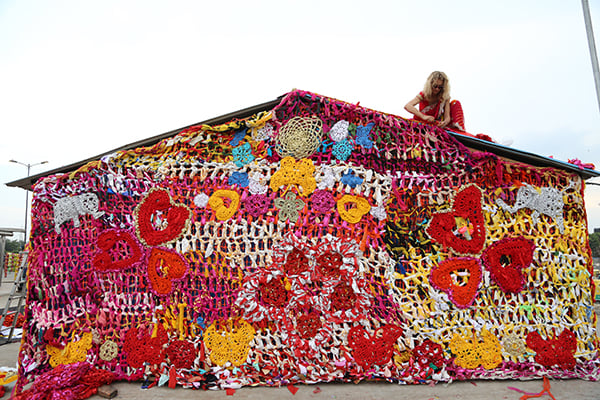
Olek transforms a women’s shelter in India for St+Art Delhi.
Photo: via Olek’s website.
The Perils of Working in Public Spaces
The Street artists working on the New York trains were the first to get the attention of the public at large, law enforcement very much included. It was clear that what they were doing was (A) perilous and (B) illegal. Vandalism was part of the equation. As the movement spread and matured though, this element has become so diffused that it has become possible to ignore. Almost.
By the late 1980s, a growing number of artists were making Street art into a career usually by combining legal commissions with attention-grabbing illegal works while maintaining a studio practice. Why should artists to whom other doors are open choose to work the sometimes wild world of the streets? Well, the potential fan base ain’t irrelevant.
Patrick McNeil and Patrick Miller met as art students at Northern Arizona University. They moved into design, traveled, met up again and in the late 90s they launched Faile in New York.
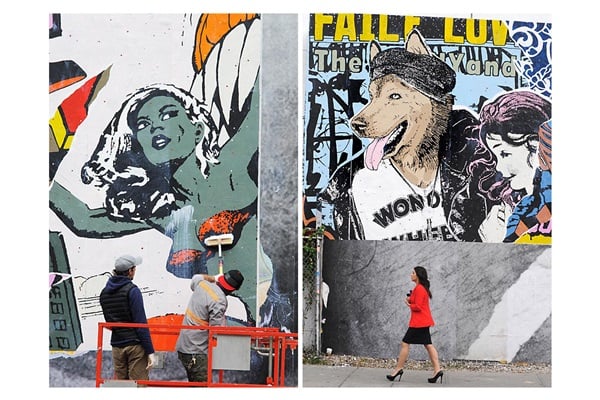
Faile, wall at Houston and Bowery.
Photo: Courtesy of Martha Cooper.
Anthony Haden-Guest
Not so long before you graduated most young artists would set out to find a dealer, get a show, make a sale, etc. You took a different route. Why?
Patrick McNeil
I had some early exposure to stencil art in Brighton. The first time I saw it I was really inspired. And then moving to New York in 1997, just seeing the streets come alive! It was like nothing I had ever seen growing up in Arizona and Canada, there was just all this graffiti. It was such a rich tapestry of visual information happening on the street. And walking every day from my work to lunch and seeing people interacting with it, or to seeing elements interacting with it was really kind of fresh and inspiring. It grabbed our attention. And made us want to interact with it. It kind of happened as a very organic thing. We just dived into it and got captured by it. And before we knew it, we were traveling and putting up work.
Patrick Miller
At the time we were at school we were making a lot. We were making our own work and doing independent studies on the side. So it really gave us an outlet for the work we were making without getting permission from anybody else to do it.
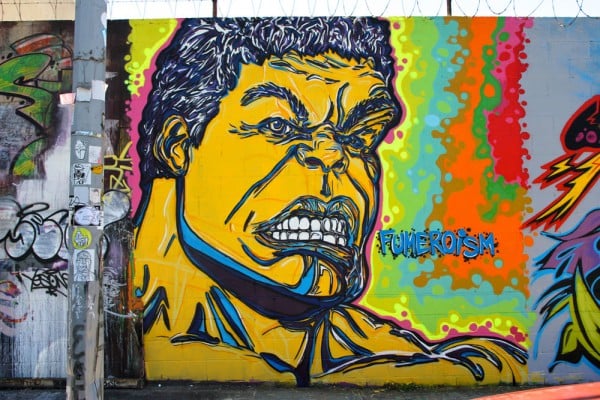
Mural by Fumero.
Image: via Fumero’s website.
Many Street artists, even those that keep their hand in the game by doing an illegal tag from time to time, have, by and large, little problem with having their identity known these days. Banksy is one notable exception. Fumero is another.
AHG
How does a Street artist get attention starting out?
Fumero
You did it where nobody looked at it. You did it on the back of a factory. You just did it to do it. To get that picture, to have it up, to be able to come back in the daytime and look at it. And definitely to have a photograph of it because you know it will go away in a bit. But in recent times, in my professional life, you build in places where people are going to come, they’re going to see it. Even if it’s in an alleyway, it doesn’t matter. People go out. It’s such a popular genre of art.
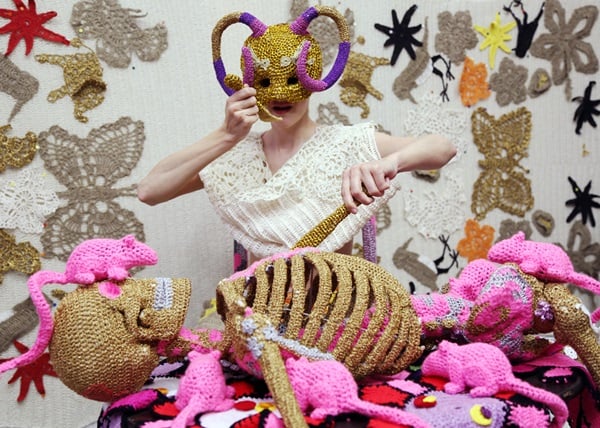
Olek. Dinner Party (1996).
Photo: Courtesy of the artist.
Olek wrote a thesis on Symbolism in Costume in the Films of Peter Greenaway at her university in Poland. A costume designer advised her to move to New York. She arrived in 2000, aged 22, and enrolled in La Guardia Community College.
Olek
People thought I was a costume designer from Poland. So I made costumes for this dance company. An instructor, Michael Rodriguez, gave me my first show. It was a big challenge because I had never made sculptures out of fabric. I stopped by a 99 cent store and bought some materials. At home I was trying to figure out the best way to make something out of it. I thought of gluing things together and braiding them. And then I thought, “How about crochet?” It was something that I knew how to do. I started doing it when everyone was in school. I crocheted one lane of the swimming pool. I always was escaping this idea of being an artist. And finally when I hit on this way of doing what I had to do, I really sort of exploded.
AHG
Why were you escaping from the idea of being an artist?
Olek
Because of the bad experience that I had in elementary school. When I was fourteen, a kid, I was painting, drawing, always doing something with my hands. I was drawing from the TV screen, making all the different characters. And I was supposed to go to the high school of art. I came up with an idea. And the teacher said, “You think you are Picasso! You are nothing.” And I said to her, “I don’t need your recommendation for art school.” So I went to high school.
AHG
You began doing performance installations but street work hadn’t figured in your plans. How did that come about?
Olek
I did this project during the Istanbul Biennial in 2005. And there were artists wanting an installation in the gallery and they were fighting about the walls. And I go, “Fuck this! I’m not going to fight over the walls. Take all the walls.” I told the gallery owner there was no space inside so I am going to present something outside.
AHG
What did you do?
Olek
I crocheted the gallery owner’s car. I think artists that work in public spaces, they connect together quite well. Very well. It’s the opposite for artists who only work in the galleries. Simply because there are endless opportunities in our space for us to do something. We don’t have to fight, we support each other. The biggest supporter of my work was Futura 2000. He wrote me an email when I started working. I said, “Who is this guy? Futura 2000? Who is sending me all the emails almost every day with pictures of my work?” They said, “You don’t know who he is?” And then I was like, “Oh my God! It’s amazing that this guy would recognize me.” He actually commissioned me to make a sculpture. He’s a really big supporter of younger artists. He smokes Camels with no filters and he always gives me a pack of Camels. And I smoke one cigarette before doing a public work somewhere. That’s my tradition.
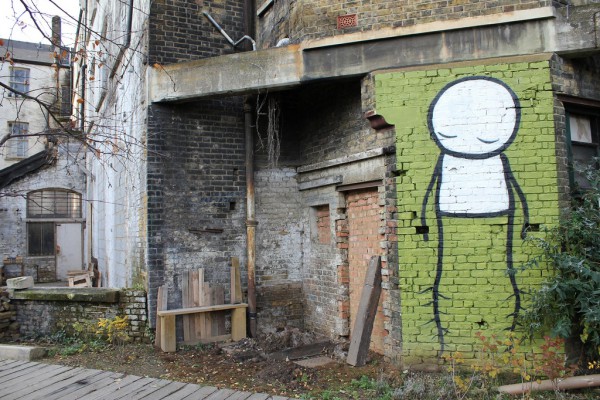
Stik.
Photo: Courtesy of Street Art London.
The vulnerability of Street art is a given. Well, all art is vulnerable, especially in these times, but Street art is particularly at risk—from the authorities, from development, from the rivalrous (especially so for Art Stars, like Banksy), and from random passers-by. The more figurative the work, the more sure it is of embellishment, a finding confirmed by the Londoner, Stik.
AHG
Why do you draw stick figures, specifically?
STIK
It’s like a portrait from the inside—an internal representation of your body. We feel our bodies as lines of consciousness. It’s like an equation. And doing just enough to get that spark. You only need to do something that’s alive. And you can tell when there’s life. You can tell a stuffed animal from a real animal. You can see, even in a photograph, that there’s something there.
AHG
What reaction do you get?
STIK
People quite often draw genitals on them. That’s a favorite. They always draw cocks and tits.
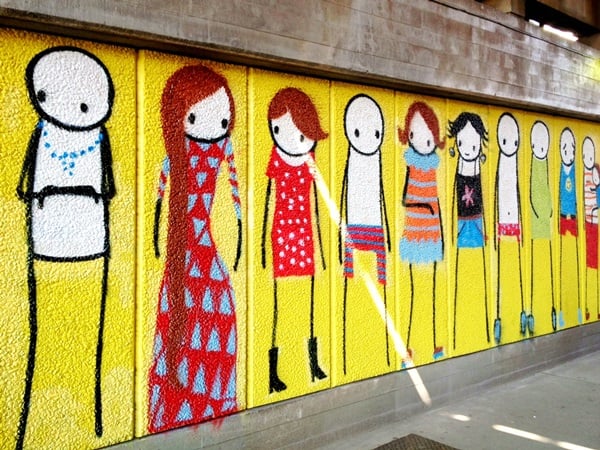
Stik.
AHG
Well, they are figurative. Aren’t you asking for it?
STIK
It is asking for it. In a way I kind of like it. But I do go around twice a week and I touch up all of the work.
I brought up the subject to Faile.
AHG
About a year ago I curated a show at a short-lived gallery on 21st and 11th Avenue. On the wall opposite was one of these Street art hubs. People were trekking there from all over the city. That building’s gone. Just up on 22nd street Kenny Scharf did a piece on the outside wall of a bar called BES. The bar’s gone. The life-cycle can be very short, no?
Patrick Miller
Absolutely. Our original name was A Life. And part of the reason was the artwork had a life. There was something fascinating about that lifespan of the art.
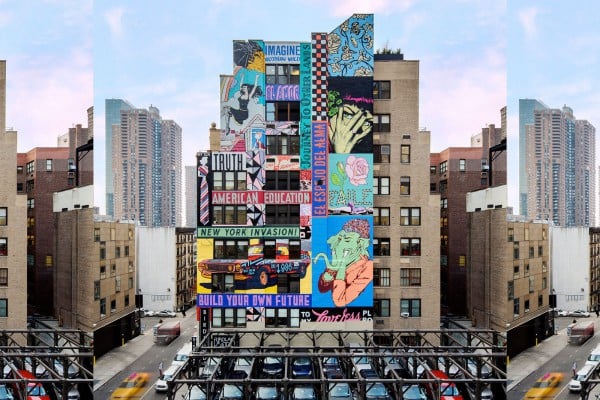
Faile.
Photo: via Faile’s website.
Patrick McNeil
It was organic. It lived. And it died. That was something that was very appealing about the process to us.
Patrick Miller
We go back and follow the changes in it a few months later.
AHG
Stik goes around and touches his pieces up. Do you do any maintenance?
Patrick McNeil
Some people are more controlling. Or they work against the elements. They like to maintain the work. But for us I think that the disintegration and that breaking down of the art is always fun to watch. Like when a poster would maybe get torn and there would be another layer beneath it. We would see the accidental juxtapositions that would just happen in that process. All that breaking down are the things that we embrace. And that ended up getting pulled into the studio practice in the way that we produce art and break up and juxtapose and paint over things and just don’t hold to things so preciously. In Street art the life of it just informs the work.
Patrick Miller
I think one thing in particular when you talk about photographing and documenting it is that Street art in the modern form has really gone parallel with the Internet. That really means that somebody can do a small amount of work but people keep photographing it. On the computer there are so many pieces that we didn’t put up. That’s really a big part of the Street art story.
AHG
Do you care when you get tagged over?
Fumero
That’s part of it. But that’s the gallery of the streets. You have to deal with Mother Nature and the elements.